| |
# |
Site |
Comments |
Photo |
Visits |
31 |
Chickamauga
Chickamauga National Military Park
Georgia

|
Chickamauga was a huge and confused battle on 19-20 Sep 1863, with ~125,000 men engaged and huge losses: 28% of each side. Through a misunderstanding of troop positions, a gap opened in Union lines just at the time of Gen. Longstreet's attack with the left wing of Gen. Braxton Bragg's rebel army. What could have been a rout of Gen. W.E. Rosescrans' Union army was averted when Union Gen. George Thomas rallied troops at Snodgrass Hill, and earned the sobriquet "The Rock of Chickamauga." It was a Pyrrhic victory for Bragg, as Rosecrans retreated to Chattanooga with an intact army (soon to be replaced by Grant).
The Park was established in 1890, and original boundaries were too small to encompass the full panoply of battle. Today's battlefield seems gerrymandered among private lands, and the tour route seems confusing. Recent Civil War Trust acquisitions of additional land will help. I suppose it didn't help that the most recent visit was during a drenching rainstorm.
|
 Snodgrass House (top) and period art of the Chickamauga battle (below; Mar 1997)
Snodgrass House (top) and period art of the Chickamauga battle (below; Mar 1997) |
June
1967,
Mar
1997 |
32 |
Prairie Grove
Prairie Grove State Battlefield
Arkansas

|
The Prairie Grove campaign of Dec 1862 is perhaps the least known of all of the campaigns of the Civil War. CSA Gen. Thomas Hindman -- a mercurial personality who was shot & killed on his front porch after the War -- found Gen. James Blunt's division isolated in sw. Arkansas. Hindman had 11,000 men (Blunt just 7,000) and moved to destroy Blunt. In a dramatic forced march, Gen. Francis Herron's troops made 114 miles in 3 days to support Blunt. Ever aggressive, Hindman bypassed Blunt to face Herron. On 7 Dec 1862, Herron attacked Hindman. Blunt, hearing the guns, spurred his troops into the rebel flank and won the day. The rebels withdrew during the night. The battle secured Arkansas for the Union.
The countryside is mostly pristine, and the center of the battlefield is a State Park; efforts are underway to enlarge it. The State Park is a multi-purpose park, but I was impressed with its unexpected good maintenance and historical interpretation. |

Site of Herron's morning attack at Prairie Grove (Mar 1997) |
Mar 1997 |
33 |
Cedar Mountain
CWPT
Cedar Mountain Battlefield
Virginia

|
In summer 1862 Gen. John Pope was given the newly formed Union Army of Virginia. Pope moved to capture the rail junction at Gordonsville, Virginia, in August. CSA Gen. R.E. Lee had sent Gen. T.J. Jackson north to deal with Pope’s army. Finding Pope’s army divided, Jackson met Union Gen. Nathaniel Banks’s corps near Cedar Mountain, a local landmark, on 9 Aug 1862. Confederates actually out-numbered Union forces 2 to 1 but during a prolonged artillery duel it was CSA Gen. Charles Winder who was killed by shell fragments. A Union attack went well until “Stonewall” personally rallied retreating troops by swinging his sheathed sword above his head (the sword had rusted into the scabbard). A Southern counterattack by Gen. A.P. Hill won this hot August day. R.E. Lee used the victory to springboard his first northern invasion.
This site was not available to the public until ~2012. The Civil War Trust acquired over 250 acres and set up a fine walking path with excellent signage. Interesting sidebars here include Clara Barton’s first field duty as a Union nurse, and Mathew Brady photographer Timothy O’Sullivan’s first photographs of a battle aftermath (a photo of dead horses). |
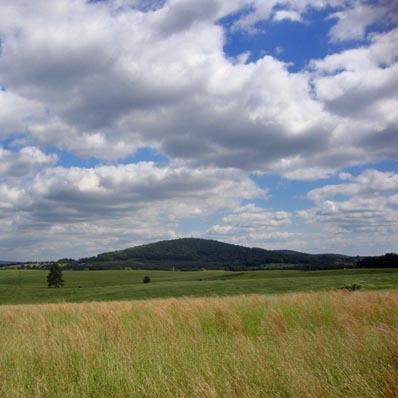 Cedar Mountian rises above the Battlefield (May 2013) Cedar Mountian rises above the Battlefield (May 2013) |
May 2013 |
34 |
Second Manassas
(Second Bull Run)
Manassas National Battlefield Park
Virginia

|
It is almost impossible to interpret two 100-year old battles that were fought on essentially the same spot. It is inevitable that only one battle can be highlighted -- and the Park Service has chosen to emphasize First Manassas. With ~124,000 men involved (nearly 50K Confederate, 75K Union), Second Manassas on 29-30 Aug 1862 was twice as large a battle, and more important strategically than First Manassas. Lee's victory here over Union Gen. Pope, accomplished via Gen. Longstreet's flank attack on 30 Aug, opened the door to Lee's first invasion of the North.
Yet the battle's interpretation is hindered by the primary focus on First Manassas, and by the fact that some important locations in Second Manassas are not part of the Park. Further, heavy traffic on fast-moving roadways that bisect the Park inhibit the visitors' experience. We were almost run over by impatient rednecks during our last visit to Second Manassas sites, and then they flipped us off. It was not a good visit.
|
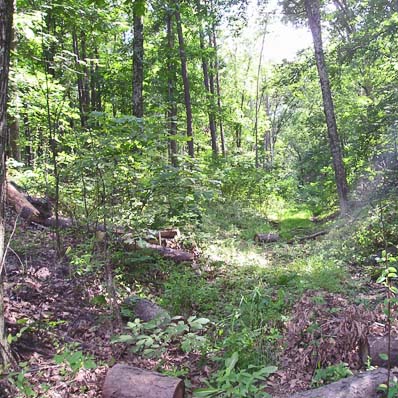 The site of the unfinished railroad cut at Second Manassas, one important key to the battle, is now heavily overgrown with forest (June 2009)
The site of the unfinished railroad cut at Second Manassas, one important key to the battle, is now heavily overgrown with forest (June 2009) |
June
1967,
June
2009 |
35 |
Bentonville
Bentonville State Historic Site
North Carolina

Bentonville battle monument
|
Bentonville was the last major battle in the deep South. Sherman had captured Atlanta in Sep 1864 and marched to the sea at Savannah; there, he turned north into North Carolina with a plan to eventually hook up with Grant in Virginia. The remnant rebel army under Gen. Joe Johnston looked for a way to attack. In mid-March 1865, while Sherman's army was split on two parallel routes. Johnston massed his forces to attack Sherman's left wing at Bentonville on 19 Mar 1865. The armies charged and counter-charged without either gaining the upper hand. The next day Sherman's entire army was brought up, and attacks on 21 March forced a southern retreat. Johnston surrendered the next month.
The battlefield is nicely maintained but the landscape -- forest and fields -- make it difficult to follow military operations. The displays at Harper House are nice, with a focus on battlefield hospitals. Recent major land acquisitions by the Civil War Trust, when developed with interpretation, will greatly enhance future visits. |
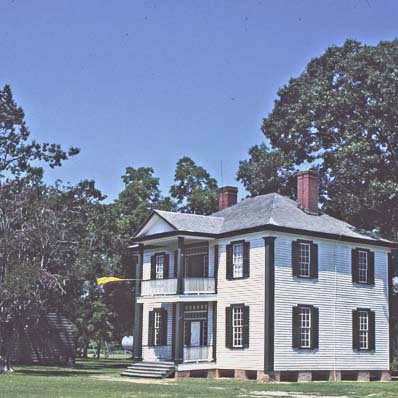
The Harper House on Bentonville battlefield, used as
a Union hospital during the battle (Aug 1997) |
Aug
1997 |
36 |
Battle of Atlanta
Atlanta Cyclorama
Georgia

|
The Battle of Atlanta was a huge campaign by Union Gen. W.T. Sherman from 20 July-31 Aug 1864 to capture this key southern city. The Confederacy replaced Gen. Joe Johnston with Gen. John B. Hood. He attacked Sherman at Peachtree Creek on 20 July, at Atlanta on 22 July [Battle of Atlanta], and Ezra Church on 28 July, but Sherman just extended his encirclement. He attacked again at Jonesboro on 31 Aug-1 Sep but failed, and Atlanta fell by the evening of 1 Sep 1864. The city was burned, largely by retreating rebels.
Virtually all the battle sites have been lost to urban development. One must drive deep into suburbia to find, for example, the statue of Union Gen. McPherson, once considered the brightest of rising stars, who died in the Battle of Atlanta. The Atlanta Cyclorama in Grant Park, though, is spectacular. at 15,030 sq.ft. it is the world's largest oil painting, weighing over 10,000 lbs. A diorama provides 3D depth in front as the audience completes the 360° circuit of the battle view.
|
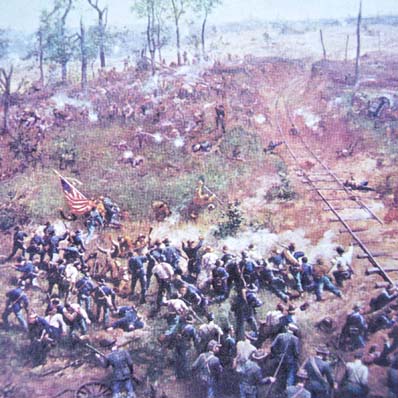 A portion of the Atlanta cyclorama (Mar 1997)
A portion of the Atlanta cyclorama (Mar 1997) |
Mar
1997 |
37 |
Bennett Place
State Historic Site, Durham
North Carolina

|
After Lee surrendered to Grant on 9 Apr 1865, only Gen. Joseph E. Johnston's army was left as significant southern resistance. Gen. William Tecumseh Sherman had by then amassed 80,000 troops. Johnston, who had 30,000 men, saw it was hopeless. Sherman was receptive to negotiations, and met Johnston at Durham Station for a 2-day conference at the James Bennett home. Peace terms were agreed but as these intruded on politics, officials in Washington rejected the agreement, criticized Sherman's imprudence, and put Grant in charge. But Grant, in a complex bit of diplomacy, communicated with Sherman by wire, proposed terms likes those at Appomattox, and supported Sherman by retaining him to accept Johnston's surrender on 26 April 1865.
The Bennett home is nicely preserved, and this small site is well worth a visit.
|
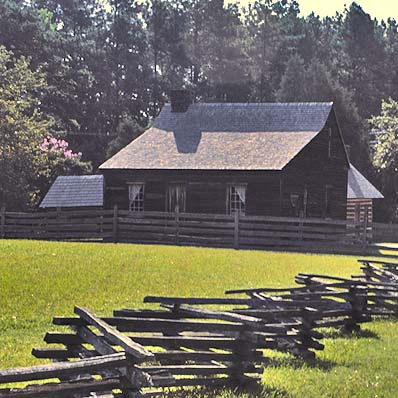 Bennett Place, site of Johnston's surrender to Sherman (Aug 1997)
Bennett Place, site of Johnston's surrender to Sherman (Aug 1997) |
Aug
1997 |
38 |
Ft. Fisher
Ft. Fisher State Recreation Area
North Carolina

|
Located on the southern tip of Pleasure Island near Wilmington, Fort Fisher lies between the Atlantic Ocean on the east and the Cape Fear River on the west. The Confederates built a huge fort there in 1861 -- primarily of casements and packed sand -- to protect commerce to Wilmington. It was the last southern port open to trade into 1864. The first Union effort to take it on 23 Dec 1864 was bungled -- but included blowing up a ship packed with 215 tons of gunpowder -- but a sea-land operation on 6-15 Jan 1865, led by Gen. A.H. Terry, finally captured the fort and closed the Cape Fear River to Confederate blockade runners.
The Atlantic Ocean has washed away some of the fort but the remaining portion is well-preserved, and a boardwalk takes a visitor through the dunes to the impressive fortress. |
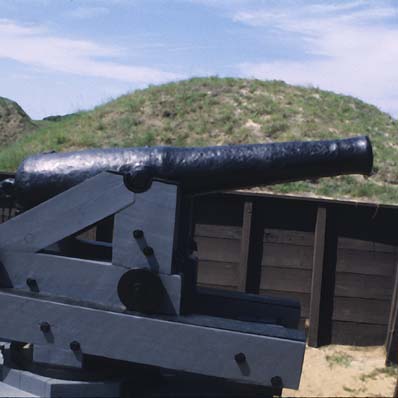
Seaward battery at Ft. Fisher (Aug 1997) |
Aug 1997 |
39 |
Cold Harbor
Cold Harbor Battlefield, Richmond National Battlefield Park
Virginia

|
In spring 1864 U.S. Grant's campaign to defeat R.E. Lee and end the War led to bloody battles at the Wilderness, Spotsylvania Court House, North Anna, and finally Cold Harbor. By the time of Cold Harbor on 3 June 1864, fighting had evolved to trench warfare with new efficient weapons. Grant's final attack here, a gamble that had it succeeded would have shortened the war, was a failure. The loss caused Grant to change strategy, move his Army south of Richmond and lay siege to Petersburg, and win eventual victory by spring 1865, nearly a year later.
Evidence of the trenches at Cold Harbor are visible today, but time has softened their contours and woods have overgrown the battlefield. It is a sad and depressing place. The heavy use of trench warfare by both armies at this point was an eerie prelude to similar tactics in World War I. Grant himself wrote in his memoirs that "I have always regretted that the last assault at Cold Harbor was ever made." It was a risk that did not succeed.
|

Trenches at Cold Harbor are today overgrown with woods (Aug 1997) |
June
1967,
Aug
1997 |
40 |
Andersonville
Andersonville National Historic Site
Georgia

|
Andersonville
Prison, set in deep south Georgia, was the largest Confederate military
prison of the Civil War. More than 45,000 Union soldiers were confined
here from Feb 1865-Apr 1865; almost 13,000 died from disease, exposure,
malnutrition, over-crowding, and poor sanitation. Capt. Henry Wirtz was
in charge during this bleak period, with very little resources to help,
but was one of the very few Confederate officers executed after the War.
This
historic site was only acquired in 1970, but the Park Service has done
an exceptional job in providing interpretation. The old stockade walls
and camp have been partially reconstructed, and historic photos appear
on signs throughout the ring drive around the camp. During our visit in
Dec 2006, ground fog added to the eerie feeling of being surrounded by
death. A museum devoted to prisoners is at the site, but was closed for
renovations during our lone visit. |
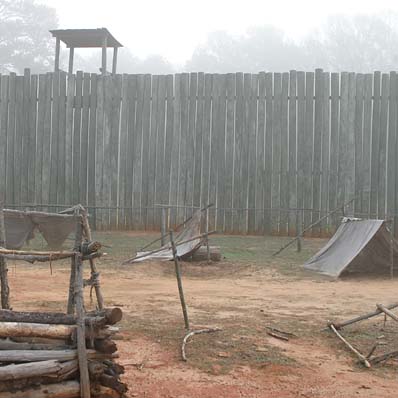
Reconstructed stockade walls and tents at Andersonville ( Dec 2006) |
Dec 2006 |
|
RECOMMENDED BOOKS & MEDIA :
31. Battle of Chickamauga
- Books: Peter Cozzens' (1992) This Terrible Sound: the Battle of Chickamauga does a thorough job of unraveling this sprawling fight, but could use even more maps and photos. At 536 pages, though, it is long; the sorting out of the "denunciations" at the end is worth the wait. A briefer but still compelling overview may be found in the multi-volume works, such as Shelby Foote's (1963) The Civil War: A Narrative (Fredericksburg to Meridian), vol. 2 of his trilogy.
32. Battle of Prairie Grove
- Books: William L. Shea's (2009) Fields of Blood: the Prairie Grove Campaign is one of the very best Civil War battle histories I've ever read. Entertaining reading from to back, well-researched and foot-noted, with maps and period photos, it is just great. I also have Michael E. Banasik's (1996) Embattled Arkansas: the Prairie Grove Campaign of 1862, but at 493 pages, I haven't had the courage to face it yet. I don't doubt the scholarship, but at a glance it seems to have TMI (too much information). Shea's book tells the whole story in 287 pages.
33. Battle of Cedar Mountain
- Books: Robert Krick's (1990) 'Stonewall' Jackson at Cedar Mountain is the authorative account of this battle. It is well researched and exceptionally detailed, with good maps. The author is a big Jackson fan, but if one knows that and can live with it, it does not distract from the vivid picture of this hot August afternoon.
34. Battle of Second Manassas (Second Bull Run)
- Books: I don't doubt that John J. Hennessy's (1993) Return to Bull Run: the Campaign and Battle of Second Manassas is "the deepest, most comprehensive, and most definitive work on this Civil War campaign, by the unchallenged authority," as it says on the cover, but I do admit that, at 472 pages, I haven't yet attempted it. It waits on the shelf for the right rainy day.
35. Battle of Atlanta
- Books: Albert Castel's (1992) Decision in the West: the Atlanta Campaign of 1864 is a big sprawling book (572 pages with appendices), heavily foot-noted, but oddly written in the first-person as if being reported contemporaneously from the field. I find that writing disconcerting but don't doubt the scholarship. I also have a series of essays published in 1994 as The Campaign for Atlanta & Sherman's March to the Sea (T.P. Savas & D.A. Woodbury, eds. I have not yet read these, but the topics appear to be of interest.
36. Battle of Bentonville
- Books: There are two books on Bentonville. Mark L. Bradley's (1996) The Battle Of Bentonville: Last Stand In The Carolinas gets the best reviews, but at 575 pages it was just a bigger book than I wanted. Nathaniel Cheairs Jr. Hughes' (2006) Bentonville: The Final Battle of Sherman and Johnston was more what I wanted (375 pages), but I have not actually yet read it.
37. Bennett Place
- Books: Mark L. Bradley's (2000) This Astounding Close: The Road to Bennett Place covers the closing chapters of the War in North Carolina, and the surrender by Joseph E. Johnston to Sherman. Again, I have not yet read it, so cannot give much of a review.
38. Fort Fisher
- Books: Rod Gragg's (1991) Confederate Goliath: the Battle of Fort Fisher was entertaining and has many period photographs. Ivan Musicant's (1995) Divided Waters: the Naval History of the Civil War also has a pertinent chapter.
39. Battle of Cold Harbor
- Books: Gordon C. Rhea's (2002) Cold Harbor: Grant and Lee, May 26-June 3, 1864 is the modern standard. It is excellent, well up to the high standards set by Rhea's earlier three volumes on Grant's 1864 "overland campaig," and provides exciting new perspectives about Grant and his strategies here. Unlike the convention wisdom, Grant was not a "butcher" for his Cold Harbor attacks. Rather, he was taking a risk that, had it succeeded, would have seriously shortened the War.
40. Andersonville
- Media: The 1996 movie Andersonville,
directed by John Frankenheimer and starring Frederic Forrest and
William Macy, among others, is loosely based on the diary of John
Ransom, a Union soldier imprisoned there. Although points of the plot
are fabricated, the general conditions of the camp shown are reasonably
accurate. The 1970 movie The Andersonville Trial,
directed by George C. Scott and starring a young William Shatner,
dramatically depicts the prosecution of Henry Wirz for atrocities
committed against Union prisoners at Andersonville. Both are
recommended.
- Books: William Marvel's (1994) Andersonville: The Last Depot is excellent, with a good selection of period photographs.
|
or the choices via links at right:
|
|
|
|
|






 Cedar Mountian rises above the Battlefield (May 2013)
Cedar Mountian rises above the Battlefield (May 2013) 












